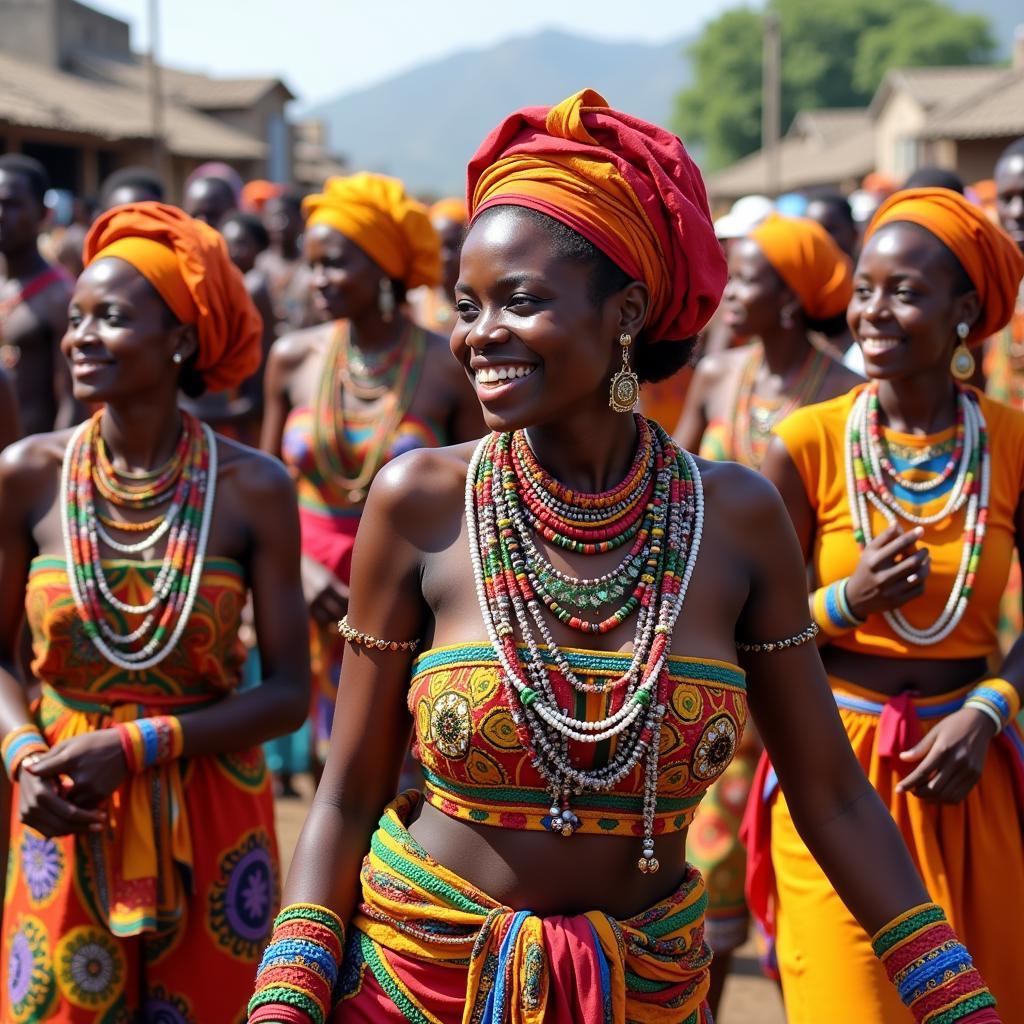African Cichlids Mbuna: A Colorful Guide to Lake Malawi’s Rock-Dwellers
African cichlids, renowned for their vibrant colors and fascinating behaviors, are a favorite among aquarists. Among these captivating fish, the mbuna stand out, captivating enthusiasts with their unique beauty and lively personalities. Native to Lake Malawi in East Africa, mbuna cichlids are rock-dwelling species that bring a touch of the African Rift Valley to home aquariums.
 Mbuna Cichlids in Their Natural Rocky Habitat
Mbuna Cichlids in Their Natural Rocky Habitat
Understanding Mbuna Cichlids: More Than Meets the Eye
“Mbuna” translates to “rockfish” in Tonga, reflecting their preference for rocky habitats where they find food and shelter. Unlike their open-water counterparts, these cichlids have adapted to a life amongst rocks, displaying unique physical and behavioral traits.
Mbuna cichlids are relatively small, typically reaching 3-4 inches in length, making them suitable for a variety of aquarium sizes. They possess laterally compressed bodies, allowing them to navigate through tight crevices and caves within their rocky domain. Their striking colors and patterns serve various purposes, from attracting mates to intimidating rivals.
Popular Mbuna Types: A Kaleidoscope of Colors and Patterns
The diversity of mbuna cichlids is truly astounding, with hundreds of species identified and new ones constantly being discovered. Each species boasts its own unique appearance and temperament, contributing to the allure of these fascinating fish.
Here are some of the most popular mbuna types found in the aquarium trade:
- Yellow Lab (Labidochromis caeruleus): True to its name, this mbuna sports a vibrant yellow body, making it a standout in any aquarium.
- Electric Blue Ahli (Sciaenochromis ahli): As its name suggests, this mbuna is known for its striking electric blue coloration.
- Red Zebra (Maylandia estherae): This species displays a vibrant orange-red body, often with darker vertical bars, resembling the pattern of a zebra.
- Auratus Cichlid (Melanochromis auratus): This fish is characterized by a horizontal black stripe that runs the length of its body, contrasting with its bright yellow or orange coloration.
- Snow White Socolofi (Chindongo socolofi): This species is predominantly white with black markings on its dorsal fin and a black stripe across its eye.
“When choosing mbuna for your aquarium, it’s important to research their individual temperaments and compatibility,” advises Dr. Amina Kombe, an aquatic biologist specializing in African cichlids. “Creating a harmonious environment is key to their well-being.”
Mbuna Cichlid Care: Recreating a Touch of Lake Malawi
Replicating the natural environment of mbuna cichlids is crucial for their health and well-being in captivity. Here’s a comprehensive guide to providing optimal care:
- Aquarium Setup: A tank size of at least 30 gallons is recommended for a small group of mbuna. The aquarium should be decorated with rocks and caves, creating ample hiding spaces and mimicking their natural habitat.
- Water Parameters: Mbuna thrive in alkaline water with a pH between 7.8 and 8.6 and a temperature range of 75-82°F (24-28°C).
- Filtration and Water Changes: Efficient filtration is essential to maintain water quality. Regular water changes of 25-50% every two weeks are crucial to remove accumulated waste products.
- Diet: Mbuna cichlids are primarily herbivores, feeding on algae and plant matter in the wild. In captivity, their diet should consist of high-quality cichlid pellets formulated for herbivores, supplemented with blanched vegetables like spinach and zucchini.
Mbuna Cichlid Tank Mates: Choosing Compatible Companions
Mbuna cichlids are known for their territorial behavior, especially among males of the same species. Therefore, choosing suitable tank mates is crucial to prevent aggression and ensure a harmonious community tank.
Here are some compatible tank mate options for mbuna cichlids:
- Other Mbuna Species: It’s possible to keep multiple mbuna species together, provided the tank is large enough to offer sufficient territory for each fish.
- Peacocks (Aulonocara): These colorful cichlids are generally peaceful and can coexist with mbuna, adding to the visual appeal of the aquarium.
- Synodontis Catfish: These bottom-dwelling catfish can be good companions for mbuna, as they occupy a different water column and help control algae growth.
African Cichlids: A Rewarding Aquarium Experience
Keeping African cichlids, particularly the rock-dwelling mbuna, offers a rewarding experience for both novice and seasoned aquarists. By understanding their unique requirements and providing appropriate care, you can enjoy the vibrant colors, active behaviors, and captivating personalities of these fascinating fish from Lake Malawi.
For more in-depth information on specific mbuna types and their care requirements, you can explore our African Cichlid Profiles. If you’re interested in expanding your knowledge further, check out our curated selection of African Cichlid Books.
FAQ: Your Mbuna Cichlid Questions Answered
1. How many mbuna cichlids can I keep in a 55-gallon tank?
A 55-gallon tank can comfortably house a small group of 6-8 mbuna cichlids, depending on their adult size and temperament.
2. What are the signs of aggression in mbuna cichlids?
Aggressive behaviors include fin-nipping, chasing, and constant displays of dominance.
3. Can I keep mbuna cichlids with live plants?
Mbuna cichlids are known to graze on plants. However, you can try incorporating hardy plant species like Java Fern or Anubias, which are less appealing to these fish.
4. How often should I feed my mbuna cichlids?
It’s best to feed them small portions twice a day. Avoid overfeeding, as this can lead to water quality issues.
5. Do mbuna cichlids need a heater?
Yes, a heater is necessary to maintain a stable water temperature within their preferred range of 75-82°F (24-28°C).
6. How can I tell if my mbuna cichlids are breeding?
Female mbuna cichlids hold their eggs and fry in their mouths for several weeks after spawning.
7. Where can I find African cichlids for sale?
You can find healthy African cichlids at reputable local fish stores or online breeders. If you’re in Washington state, check out these sources: African Cichlids for Sale Washington State. You may also find resources for other fish types: African Chichlid Fish Tupes.
Need More Help with Your African Cichlids?
For personalized advice on choosing the right mbuna cichlids and creating a thriving aquarium environment, don’t hesitate to contact our team. We’re here to assist you every step of the way. You can find suitable tank mates in this article: African Cichlid Tank Mates.
Contact us:
- Phone: +255768904061
- Email: kaka.mag@gmail.com
- Address: Mbarali DC Mawindi, Kangaga, Tanzania
Our dedicated customer support team is available 24/7 to answer your questions and provide expert guidance.

